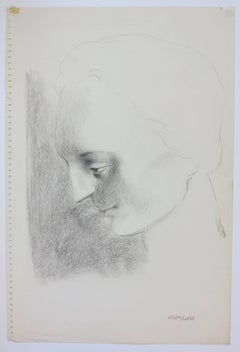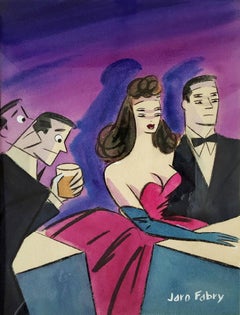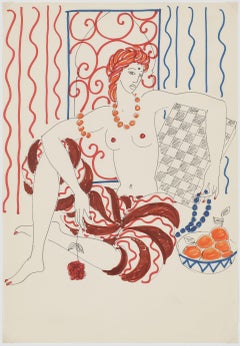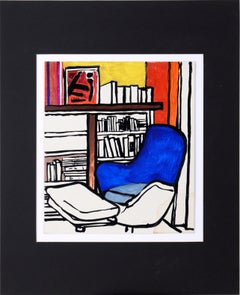Portrait Drawings and Watercolors
3
to
16
64
54
57
13
84
21
16
58
30
29
5
Overall Height
to
Overall Width
to
1,097
633
132
77
77
58
58
46
44
28
17
12
10
9
63
40
35
27
21
16
12
10
9
8
6
3
3
3
3
2
2
2
2
2
3
62
58
4
4
5
1
4
6
4
7
2
4
12
8
5
5
3
68
39
37
29
20
Portrait Drawings and Watercolors For Sale
Style: Abstract
Style: Post-Impressionist
Untitled Baseball Player
Located in New York, NY
Unknown Artist, "Untitled Baseball Player", Figurative Charcoal Drawing, 17.50 x 23.50 (In Frame 25.50 x 31), Late 20th Century
Colors: Blac...
Category
Late 20th Century Abstract Portrait Drawings and Watercolors
Materials
Charcoal
Classical Female Head (woman portrait)
Located in Wilton Manors, FL
Beautiful 1950 drawing by Spanish artist, Federico Castellon (1914-1971). Graphite on wove paper, sheet measures 12 x 18 inches. Excellent condition with no restoration or damage. Signed lower right. Unframed. From a recently discovered collection of over 60 important Castellon drawings and watercolors c.1939-1950.
Birth place: Almeria, Spain
Death place: New York, NY
Addresses: NYC (immigrated 1921; citizen, 1943)
Profession: Painter, graphic artist, sculptor, etcher, illustrator, teacher
Exhibited: Weyhe Gal., 1934, 1936-40; AIC, 1935-47 (prize, 1938); AFA traveling exh., 1937; WMAA, 1938-45; PAFA, 1938-39, 1940 (prize), 1941-42; Carnegie Inst., 1942; PAFA, 1943-53; Assoc. Am. Ar., 1946 (prize), 1952 (solo); Corcoran Gal, 1947; LOC, 1949 (prize); Paris, France, 1952; Bombay, India, 1952; Gallery 10, 1961; Dintenfass Gal., N.Y., 1963; Phila. Pr. Cl., 1964 (prize); Hudson Gld. A., 1964; Great Neck, L.I., 1964; SAGA, 1964 (prize). In 1953, under the auspices of State Dept. Specialist Div., of I.E.S., he exhibited in Venezuela, Colombia, Peru, Chile, Bolivia, Uruguay, Argentina, Paraguay, with lectures in each country. Awards: F., Spanish Republic, 1934-36; fellow, Guggenheim Fnd., 1941, 1950; Nat. Inst. A. & Let. Grant, 1950.
Member: NA; SAGA
Work: WMAA; PAFA; MoMA; PMA; MMA; BM; AIC; NYPL; LOC; Univ. KY; San Diego Mus. FA; Newark (NJ) Pub. Lib.; Princeton Univ. (Frank Jewett Mather Coll.).
Comments: A Surrealist painter whose imagery of the 1930s was greatly influenced by Dali. His full name was Federico Cristencia de Castellón y Martinez. Teacher: Columbia Univ., 1946-61; Pratt Inst., Brooklyn, 1952-61. Illustrator: Shenandoah, 1941; I Went into the Country, 1941; Bulfinch's Mythology, 1948; The Story of Marco Polo, 1954; The Man Who Changed China, 1954; The Story of J. J. Audubon, 1955; The Little Prince, 1954; The Life of Robert L. Stevenson, 1954. Reproduction of paintings on The Sumerian Civilization" for Life series "The Epic of Man," 1956; 15 paintings on "The History of Medicine" for MD magazine, 1960-61; The Story of Madame Curie...
Category
1950s Abstract Portrait Drawings and Watercolors
Materials
Graphite
Drunk man at party, Golden Age of Hollywood
By Jaro Fabry
Located in Miami, FL
During the Golden Age of Hollywood no illustrator chronicled the great stars, pin-ups and good girls better than Jaro Fabry, Work is Framed i...
Category
1940s Post-Impressionist Portrait Drawings and Watercolors
Materials
Watercolor
untitled Woman by the Windows
Located in Fairlawn, OH
Untitled (Woman by the Windows)
Unsigned.
Pastel on board, c. 1915
Created while the artist was in Giverny, France
Provenance:
Gift of the artist to his wife, Mary Hess Buehr
by Descent to the artist's niece, daughter of Will Hess.
David Salzman
Robert Henry Adams Fine Art, Chicago
Ronald C. Sloter, Columbus
One of the early Chicago artists to adopt Impressionism, Karl Buehr became a figure and landscape painter. As a figure painter, his specialty became "gorgeously colored images of young women on porches overlooking brilliant summertime gardens." (Kennedy 98) His later work often showed a female figure with serious expression engaging the viewer with a direct stare. In his landscapes, he was noted for his strong coloration. In a December 1896 student exhibition at the Art Institute, a reviewer for the "Chicago Times Herald" described Buehr's landscapes as "blithe and joyous" with "country roads brilliant in sunlight . . . fields rich in summer verdure, under soft skies painted in a high, musical key." (Gerdts 68)
Buehr was born as one of seven sons to a prosperous German family who immigrated to America and settled in Chicago in 1869. He was first exposed to his signature style of Impressionism in 1888 when he enrolled in night classes at the Art Institute while working in the shipping department of a lithographic firm near the Institute. He remained a student there until 1897 and was recognized in a "Chicago Times Herald" editorial of June 13, 1897 as one of the Institute's most outstanding pupils.
The next year, his art career was temporarily put on hold when he briefly enlisted with the U.S. Army in the Spanish American War. In 1899, he resumed his art studies, this time with Frank Duveneck. He exhibited a painting at the Paris Salon of 1900. In 1905, thanks to a wealthy Chicago patron, Buehr and his family moved to France. They spent the following year in Taormina, Sicily, and spent time in Venice as well. In Paris, Buehr studied at the Academy Julian with Raphael Collin for two years. Then he went to England, enrolling in the London Art School but had returned to Paris by 1908. During this time, he began painting at Giverny, the home of Impressionist leader Claude Monet (1840-1926, and by 1912, Buehr was listing that village as his home address. One of his good friends and associates at Giverny was Frederick Frieseke.
One of Buehr's paintings from that time, "News from Home", was exhibited in 1913 at the French Salon in Paris and at the annual exhibit of the Chicago Art Institute. It shows a woman in floral dress sitting on a porch with a background with potted flowers and lush greenery background. Of his painting done at Giverny, Buehr wrote in 1912 to William Macbeth of Macbeth Galleries in New York: "My figures painted in and around Giverny are costumed and in appropriate out door settings." (Gerdts 68)
In 1914, he returned to the United States and took a teaching position in Chicago at the Art Institute, which he held for the remainder of his life. He was married to Mary Hess, a painter of miniatures and decorative works.
In 1928-29, he was a guest artist at Stanford University.
Courtesy: AskArt
“Karl Albert Buehr (1866–1952) was a painter born in Germany.
Buehr was born in Feuerbach - near Stuttgart. He was the son of Frederick Buehr and Henrietta Doh (Dohna?). He moved to Chicago with his parents and siblings in the 1880s. In Chicago, young Karl worked at various jobs until he was employed by a lithograph company near the Art Institute of Chicago. Introduced to art at work, Karl paid regular visits to the Art Institute, where he found part-time employment, enabling him to enroll in night classes. Later, working at the Institute as a night watchman, he had a unique opportunity to study the masters and actually posted sketchings that blended in favorably with student's work. Having studied under John H. Vanderpoel, Buehr graduated with honors, while his work aroused such admiration that he was offered a teaching post there, which he maintained for many years thereafter. He graduated from the Art Inst. of Chicago and served in the IL Cav in the Spanish–American War. Mary Hess became Karl's wife—she was a student of his and an accomplished artist in her own right. In 1922, he was elected into the National Academy of Design as an Associate member.
Art Studies in Europe
In 1904, Buehr received a bronze medal at the St. Louis Universal Exposition, then, in 1905, Buehr and his family moved to France, thanks to a wealthy Chicago patron, and they spent the following year in Taormina, Sicily, where the artist painted local subjects, executing both genre subjects and landscapes as well as time in Venice. Buehr spent at least some time in Paris, where he worked with Raphaël Collin at the Académie Julian.
Giverny and American Impressionism
Prior to this time, Buehr had developed a quasi-impressionistic style, but after 1909, when he began spending summers near Monet in Giverny, his work became decidedly characteristic of that plein-air style but he began focusing on female subjects posed out-of-doors. He remained for some time in Giverny, and here he became well-acquainted with other well known expatriate America impressionists such as Richard Miller, Theodore Earl Butler, Frederick Frieseke, and Lawton Parker. It seems likely that Buehr met Monet, since his own daughter Kathleen and Monet’s granddaughter, Lili Butler, were playmates, according to George Buehr, the painter’s son. His other daughter Lydia died before adulthood due to diabetes. He returned to Chicago at the onset of World War I and taught at The Art Inst for many years. One of his noted pupils at the Art Institute was Archibald Motley...
Category
1910s Abstract Impressionist Portrait Drawings and Watercolors
Materials
Pastel
" Odalisque " YSL
Located in CANNES, FR
Yves Saint Laurent ( 1936-2008 )
Original drawing ink and felt-tip on paper ( 31 x21 cm )
provenance : Important private collection France .
these drawing(s) made in Marrakech during...
Category
1970s Fauvist Portrait Drawings and Watercolors
Materials
Ink
The Study - Interior with Blue Chair in Ink on Paper
Located in Soquel, CA
The Study - Interior with Blue Chair in Ink on Paper
Boldly colored interior scene by Michael William Eggleston (American, 20th Century). A rich blue armchair is positioned in a hom...
Category
21st Century and Contemporary Fauvist Portrait Drawings and Watercolors
Materials
Paper, Oil Pastel
Niño by Diego Rivera
By Diego Rivera
Located in New Orleans, LA
Diego Rivera
1886-1957 Mexican
Niño
Signed and dated “Diego Rivera 1935” (lower left)
Charcoal and sanguine on rice paper
A rebel against the traditional school of painting, Diego Rivera is revered as one of the greatest and most influential artists of the 20th century. Niño, completed by Rivera in 1935, represents a masterwork within an important part of the artist’s output — his portraits of children. It is a touching work paying homage to both childhood innocence and the cultural identity of the Mexican people...
Category
20th Century Post-Impressionist Portrait Drawings and Watercolors
Materials
Rice Paper, Charcoal





